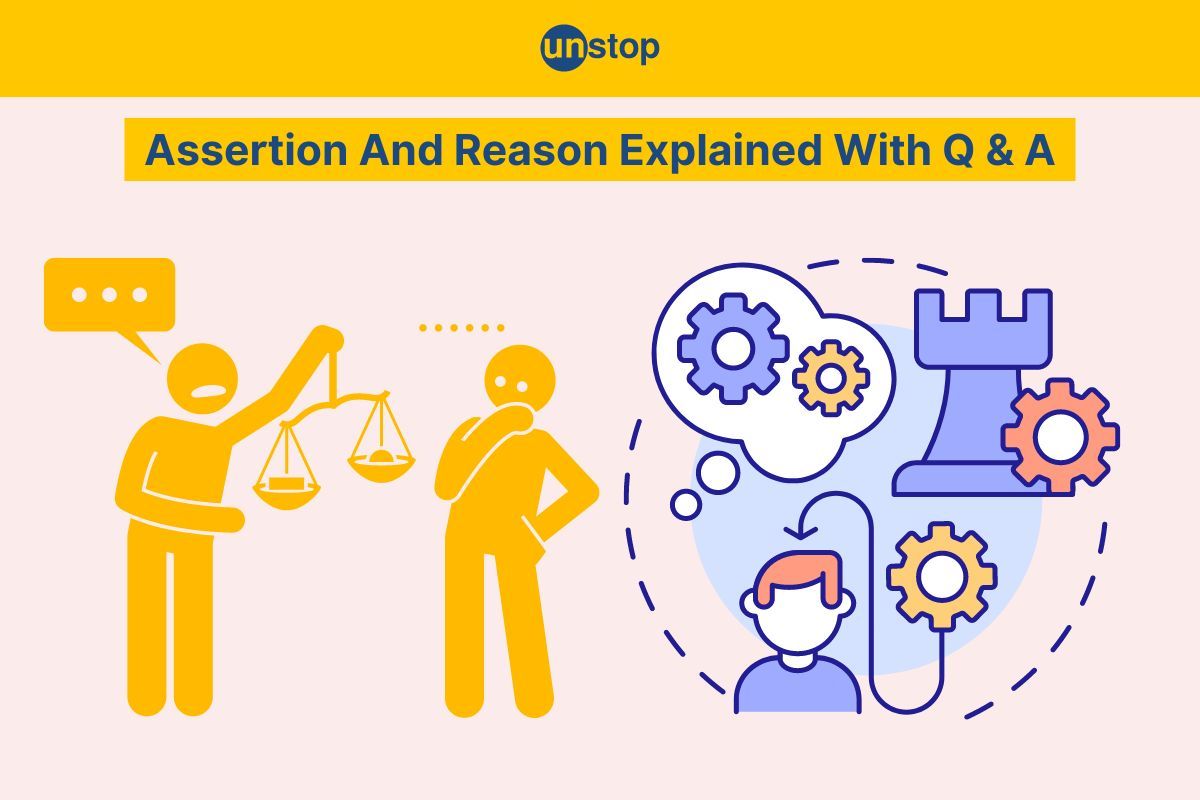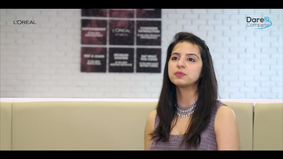- Types Of Assertion And Reason
- Tips to Solve Assertion & Reason Problems
- Solved Assertion & Reason (MCQs) with Detailed Explanation
- Conclusion
- Frequently Asked Questions (FAQs)
Assertion and Reason Questions: Concept, Solved MCQs & Explanations

For students gearing up for exams and job placements, grasping the concepts of assertion and reason is essential. Whether tackling exam questions or preparing for job interviews, mastering this interplay is key to success in academic and professional endeavours.
Understanding Assertion And Reason
Assertions are statements that express a belief or point of view, while reasons provide an explanation or evidence to support the assertion.
For example, an assertion could be "The sky is blue," with the reason being "Because of the scattering of sunlight by the atmosphere." To determine if a reason logically supports an assertion, evaluate whether the reason provides a valid explanation or evidence for the statement.
Types Of Assertion And Reason
Let us study the types of assertions and reasons:
Matching
Matching requires aligning the assertion with a reason that directly supports it. This option demands a clear connection between the two statements.
Contradictory
Contradictory options involve selecting a reason that contradicts the assertion. This type tests your ability to identify inconsistencies in given statements.
Partially Correct
In this scenario, the reason partially supports the assertion but lacks complete alignment. It challenges you to evaluate the degree of correlation between the two statements.
Irrelevant Reason
Here, the reason provided is entirely irrelevant to the assertion. This option assesses your capacity to distinguish between relevant and extraneous information.
Reverse Reason
The reverse reason option involves choosing a statement where the reason becomes the assertion and vice versa. This type evaluates your understanding of statement roles.

Tips to Solve Assertion & Reason Problems
Let us study some of the strategies and tips for assertion and reason:

Systematic Approach
Implement a systematic approach to tackle assertion and reasoning problems effectively. Start by carefully reading the statements and identifying the assertion and reason components. Then, analyze the relationship between them to determine their validity.
Critical Thinking Skills
Enhance critical thinking skills to effectively analyze A & R scenarios. Break down each statement into smaller parts and evaluate the logic behind it. Practice identifying flaws in reasoning to strengthen your analytical abilities.
Logical Reasoning
Utilize logical reasoning to improve success rates in solving A & R questions. Develop a step-by-step process to evaluate the truthfulness of both the assertion and reason. By systematically eliminating incorrect options, you can arrive at the correct answer more efficiently.
Careful Analysis
Mastering assertion and reason questions requires careful analysis of each statement to determine its validity. By dissecting the assertions and reasons, you can identify any flaws in the logic presented.
Strategic Selection
When faced with assertion and reason statements, it's crucial to strategically select the correct answer. Take your time to evaluate each option thoroughly before making a decision. Look for clues within the statements that indicate their accuracy.
Solved Assertion & Reason (MCQs) with Detailed Explanation
To excel in assertion and reason questions, it's essential to diversify practice by tackling various types of problems. Provided below are some best-selected practice questions with answers:
Q1. Assertion (A): Ebonite is used as a handle in pressure cookers.
Reason (R): Ebonite is strong.
a) Both A and R are true, and R is the correct explanation for A.
b) Both A and R are true, but R is not the correct explanation for A.
c) A is true, but R is false.
d) A is false, but R is true.
Answer: c) A is true, but R is false.
Explanation: The handles of pressure cookers are made of ebonite, a material known for its low heat conductivity. This design choice ensures that even when the pressure cooker is in use, the handle remains cool, significantly reducing the risk of accidental burns in the kitchen.
Q2. Assertion (A): Glass is cut using diamonds.
Reason (R): The refractive index of diamonds is high.
a) Both A and R are true, and R is the correct explanation for A.
b) Both A and R are true, but R is not the correct explanation for A.
c) A is true, but R is false.
d) A is false, but R is true.
Answer: b) Both A and R are true, but R is not the correct explanation for A.
Explanation: Diamonds are tough to cut due to their rigid three-dimensional structure, so they are used for cutting glass. The refractive index of a diamond is high and gives it greater transparency and brilliance.
Q3. Assertion(A): Jute is imported to Bangladesh from India.
Reason (R): Most of the jute mills are in Bangladesh.
a) Both A and R are true, and R is the correct explanation for A.
b) Both A and R are true, but R is NOT the correct explanation for A.
c) A is true, but R is false.
d) A is false, but R is true.
Answer: d) A is false, but R is true.
Explanation: When Bangladesh was created after the partition of India, the jute production areas went to Bangladesh, while the jute mills were left in India. So, India imports raw jute from Bangladesh.
Q4. Assertion (A): In winter, people prefer wearing white clothes.
Reason (R): White clothes are good reflectors of heat.
a) Both A and R are true, and R is the correct explanation for A.
b) Both A and R are true, but R is NOT the correct explanation for A.
c) A is true, but R is false.
d) A is false, but R is true.
Answer: A is false, but R is true.
Explanation: We prefer to wear dark clothes in winter because they absorb the heat and keep the body warm. However, white clothes are good reflectors of heat and are worn in summer.
Q5. Assertion(A): Graphite as an element has the property of slipperiness.
Reason (R): Graphite has free electrons.
a) Both A and R are true, and R is the correct explanation for A.
b) Both A and R are true, but R is not the correct explanation for A.
c) A is true, but R is false.
d) A is false, but R is true.
Answer: Both A and R are true, but R is not the correct explanation for A.
Explanation: Graphite possesses a layer structure with two successive layers held by weak forces that are able to slide over one another. So, graphite is slippery, and this property finds its use as a lubricant. In graphite, each carbon atom is linked to three other carbon atoms, while one electron in the carbon atom is delocalised. So, graphite has free electrons.
Q6. Assertion (A): The collection of all natural numbers less than 100 is a set.
Reason (R): A set is a well-defined collection of distinct objects.
a) Both A and R are true, and R is the correct explanation for A.
b) Both A and R are true, but R is NOT the correct explanation for A.
c) A is true, but R is false.
d) A is false, but R is true.
Answer: a) Both A and R are true, and R is the correct explanation for A.
Q7. Assertion (A): A= {a, b} and B= {a, b, c}, then A is a subset of B.
Reason (R): All subsets are finite sets
a) Both A and R are true, and R is the correct explanation for A.
b) Both A and R are true, but R is NOT the correct explanation for A.
c) A is true, but R is untrue.
d) A is false, but R is true.
Answer: c) A is true, but R is untrue.
Q8. Assertion (A): If W is the set of whole numbers and N is the set of natural numbers, then W – N = { }.
Reason (R): A – B is the set of elements of A that are not in B.
a) Both A and R are true, and R is the correct explanation of A.
b) Both A and R are true, but R is NOT the correct explanation for A.
c) A is true, but R is false.
d) A is false, but R is true.
Answer: d) A is false, but R is true.
Q9. Assertion (A): If A is the set of letters of the word ‘FOLLOW’ and B is the set of letters of ‘WOLF’, then A and B are equal sets.
Reason (R): Two sets are equal if they have an equal number of elements.
a) Both A and R are true, and R is the correct explanation for A.
b) Both A and R are true, but R is not the correct explanation for A.
c) A is true, but R is false.
d) A is false, but R is true.
Answer: c) A is true, but R is false.
Q10. Assertion (A): R= {(1, 2), (3, 4), (4, 5), (5, 6), (6, 6)} is a function.
Reason (R): The domain of a real-valued function is a subset of real numbers.
a) Both A and R are true, and R is the correct explanation for A.
b) Both A and R are true, but R is not the correct explanation for A.
c) A is true, but R is false.
d) A is false, but R is true.
Answer: b) Both A and R are true, but R is not the correct explanation for A.
Conclusion
You've now grasped the complexities of assertion and reason questions. By understanding the nuances and employing the right techniques, you can confidently tackle assertion and reasoning problems in exams or interviews. Dive deeper into related topics and continue honing your skills to excel further. Mastering assertion and reason questions will become second nature with dedication and a strategic approach. Keep practising, stay focused, and watch your proficiency grow over time.
Frequently Asked Questions (FAQs)
1. What is the significance of understanding assertion and reason questions?
Understanding assertion and reason questions is crucial as they test your analytical skills and ability to evaluate statements logically, which are essential in various academic exams and job interviews.
2. How can I effectively tackle assertion and reason problems?
To solve assertion and reason problems effectively, practice regularly, identify key phrases in each statement, analyze the logic behind them, and ensure that both parts are individually correct before determining their relationship.
3. Why are strategies important for success in tackling assertion and reason questions?
Having a set strategy helps you approach assertion and reason questions systematically, saving time during exams or interviews, improving accuracy, and boosting your confidence in handling complex reasoning scenarios.
4. How can I master assertion and reason concepts efficiently?
Mastering assertion and reason concepts involves consistent practice with diverse question types, seeking clarification on challenging topics, using reliable resources for reference, and applying critical thinking skills to dissect complex statements accurately.
5. Are there specific tips for excelling in assertion and reason assessments?
Tips for excelling in assertion and reason assessments include staying calm under pressure, reading each statement carefully, practising active listening to understand nuances, avoiding assumptions while evaluating statements, and seeking feedback to enhance your reasoning abilities.
Suggested reads:
- Mirror Image Reasoning | Concepts And Tips With Question & Answer
- Decision Making Reasoning- Key Concepts, Tips, Question & Answer
- Statements And Assumptions- Logical Reasoning Questions & Answers
- Statement And Conclusion- Question & Answer In Logical Reasoning
- Input Output Reasoning: Concept, Strategy, Questions And Answers
Instinctively, I fall for nature, music, humor, reading, writing, listening, traveling, observing, learning, unlearning, friendship, exercise, etc., all these from the cradle to the grave- that's ME! It's my irrefutable belief in the uniqueness of all. I'll vehemently defend your right to be your best while I expect the same from you!
Login to continue reading
And access exclusive content, personalized recommendations, and career-boosting opportunities.
Subscribe
to our newsletter
















Comments
Add comment